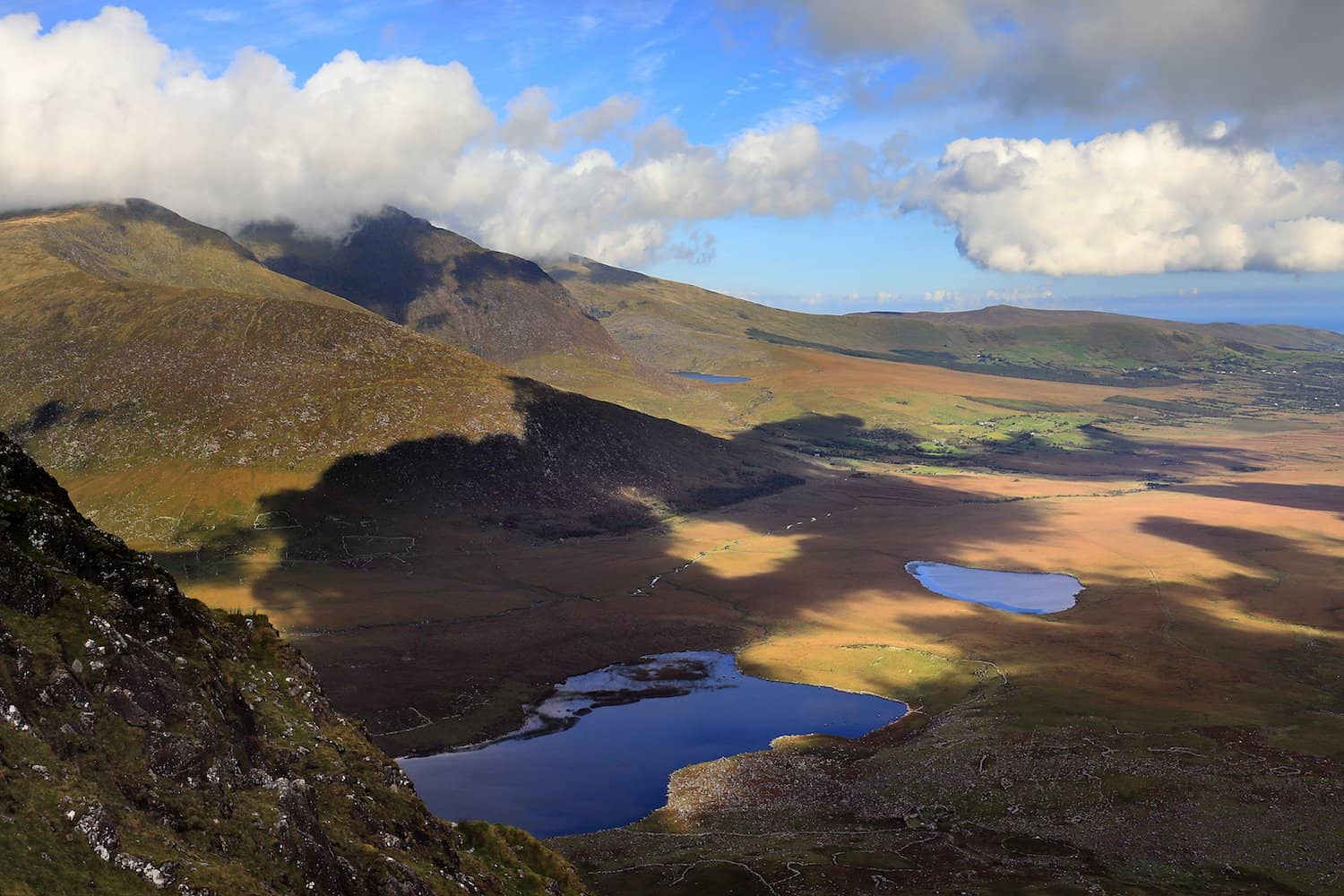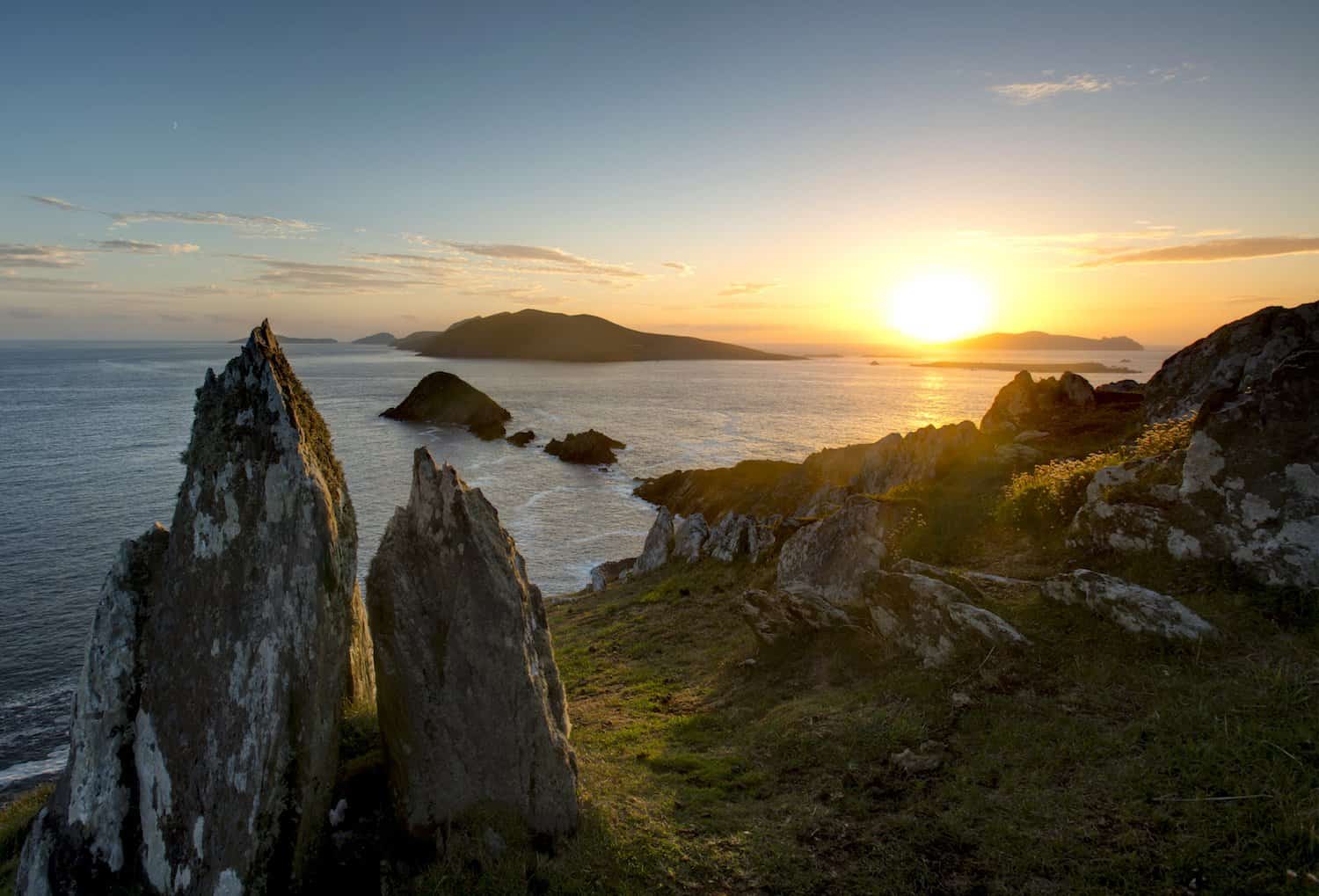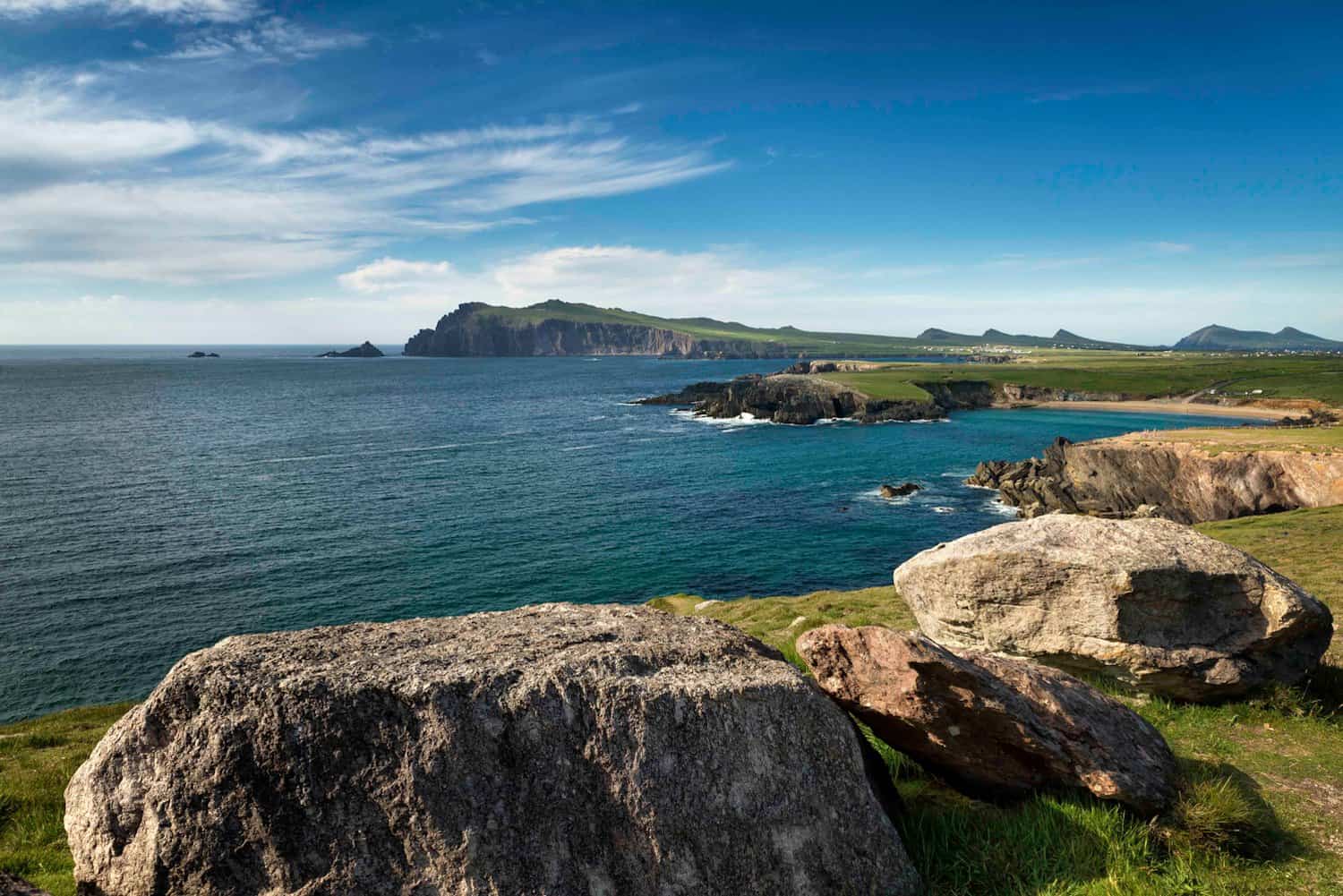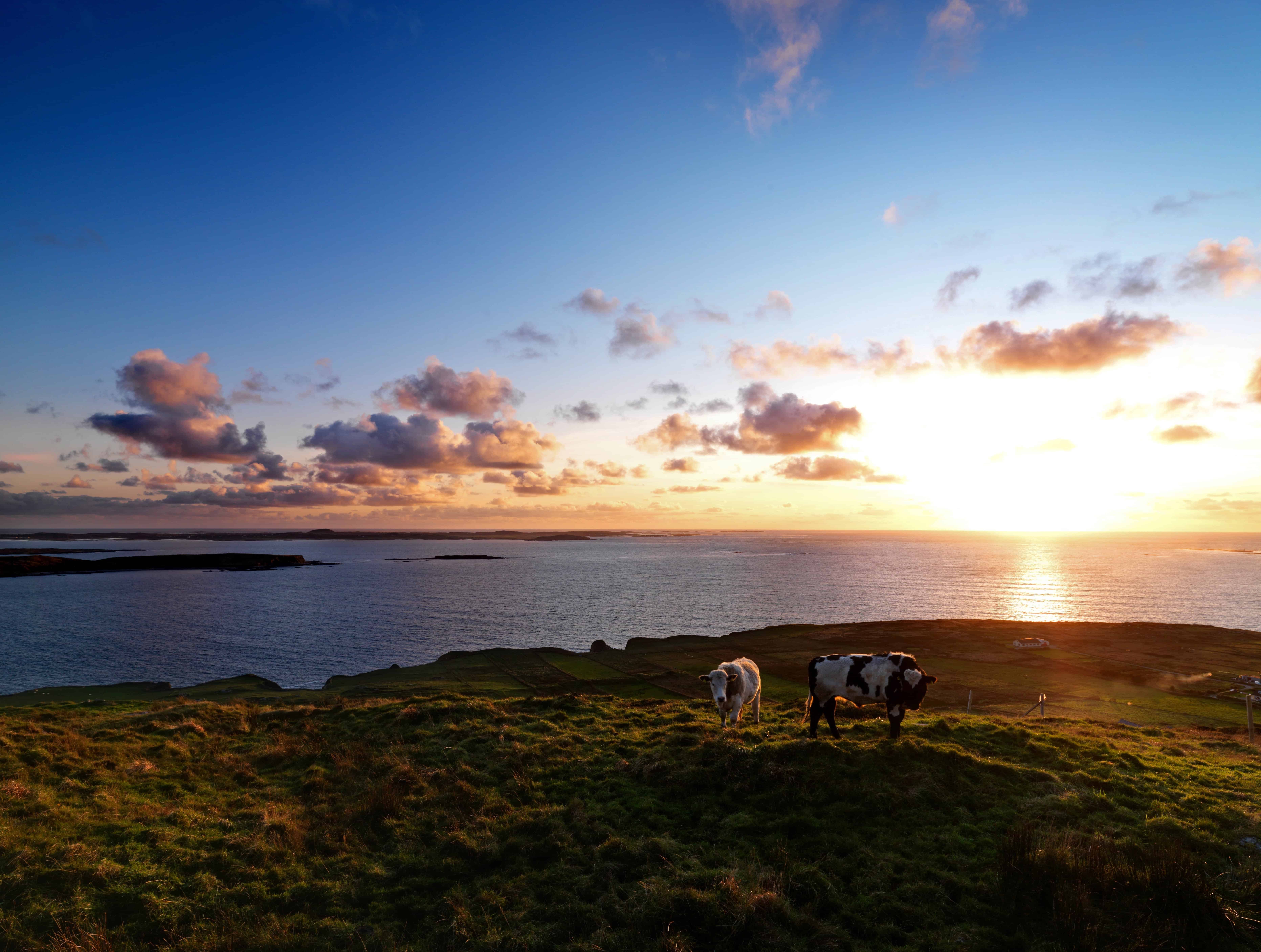There are many things that are synonymous with Saint Patrick’s Day, the color green, shamrocks, parades, pints of Guinness but one thing that is rarely alluded to is Gaelic and its history, the language that Patrick spoke in his dealings with the Irish.

Kerry; Cork; Wild Atlantic Way
Behind the Gaelic Language
Irish, or Gaelic as it is sometimes called, was the language spoken in Ireland when he lived there in the fifth century AD. This language developed from one of the Celtic dialects that became current in Ireland in the centuries before Christ presumably introduced by a group of Celts who wandered westward from their homeland in Central Europe during the previous millennium.
An exciting intellectual advance in the mid-nineteenth century was the discovery by pioneers in the science of linguistics that a genetic relationship existed between a variety of languages they designated as Indo-European.
They established that practically all the languages in the landmass from India to Ireland belonged to a distinct linguistic family (Indo-European) that included such diverse language groupings as Sanskrit, Persian, Hellenic, Slavic, Germanic, Romance and Celtic. In turn, the Celtic family of languages embraces Irish Gaelic, Welsh, Breton, Scottish Gaelic, Cornish and Manx.
A common misconception is that Saint Patrick was Irish but he was most likely a Welsh man and Welsh would probably have been his native language. But we must remember that Patrick was on a mission, a serious one, to convey the message of Christianity to the Irish people. In order to bring about the radical change from existing beliefs and lifestyle involved in the acceptance of Christianity, Patrick needed to reach people on a personal level and communicate with them in their own language.
His proficiency in Irish gave him access to the mindset of his audience and made his message more acceptable to them. Still today, the fact remains that the authentic voice of Ireland for many, many centuries, speaks the Irish language.
The earliest form of writing in Irish Gaelic is known as ‘ogham’, a name derived from the Celtic god Oghma. It consists of a series of perpendicular or sloped strokes or notches representing various letters of the Latin alphabet and is usually inscribed on the edges of upright stones.
Hundreds of these ‘Ogham Stones’ still survive today in Ireland. Though it was a rather cumbersome code of writing, ogham gave people a medium to communicate and express, and maybe most importantly, to remember and celebrate. Not surprisingly then they serve as grave markers or monuments bearing the names of people of importance to the community.
Another little-known fact is that Irish has the distinction of being the oldest recorded vernacular language in Europe. Written records of Gaelic go back at least to the early fifth century and relatively soon thereafter a hugely impressive corpus of Irish-language literature began to be created.
After the adoption of Christianity a wonderful fusion occurred between the old native oral literature and the introduced art of writing as practiced in monastic settlements. Scribes would sometimes ‘gloss’ or annotate in the margins of their manuscripts, and these glosses contain some of the most pleasing examples of early Irish literature. The poem, Pangur Bán, for instance, which celebrates the love of the scholar for his cat, was penned on the margin of a manuscript by an Irish monk in central Europe in the early ninth century. Two of its eight verses given in English translation must suffice here:
So in peace our tasks we ply,
Pangur Bán, my cat and I;
In our arts we find our bliss,
I have mine and he has his.
Practice every day has made
Pangur perfect at his trade;
I get wisdom day and night
Turning darkness into light.
During the medieval period many fine works of literature were produced in the Irish language. Among these is the epic Táin Bó Cualigne (The Cattle Raid of Cooley) describing the conflict between Queen Medb and her husband Ailil of Connacht on the one hand, and on the other, the men of Ulster with Cú Chulainn as their champion.
Another important composition is Acallam na Senórach (The Colloquy of the Ancients) which recounts the valorous deeds of Finn mac Cumhaill and his band of Fianna, and yet another is Lebor Gabála Érenn (The Book of Invasions of Ireland) which draws on earlier mythology to present a fictionalized history of Ireland. This latter work also contains one of the most striking and remarkable poems from the period, ‘Amairgen’s Hymn’ as it is sometimes called. Amairgen, an early ancestral figure, is said to have uttered it on first setting foot on Ireland:
I am a wind in the sea (for depth).
I am a sea-wave upon the land (for heaviness).
I am the sound of the sea (for fearsomeness).
I am a stag of seven combats (for strength).
I am a hawk on a cliff (for agility).
I am a tear-drop of the sun (for purity).
I am a salmon in a pool (for swiftness).
I am a lake in a plain (for size).
I am the excellence of arts (for beauty).
The Viking invasions between the eighth and tenth centuries left lasting traces on the culture and language of the population. Many typically Scandinavian words are found in modern Irish, in particular those relating to ships and navigation and fishing. For instance, trosc the Irish word for the fish, cod, comes from the Old Norse.
The next settlers, the Normans in the twelfth century, brought about a strong French influence, in particular on the literature of the period. Some of the southern dialects of Irish are still detectably influenced by Norman French, and contain several typically French words like ‘garsún’ (boy) from French garçon.
In the seventeenth century, under English rule, practically all the Irish chieftains were deprived of their land and forced to flee or become tenants of the newly planted English landlords. Irish literature went into decline as the system of patronage which had supported it was no longer upheld by the new landlords. For many people education continued only in unofficial ‘hedge schools’.
When the first ordnance survey team arrived in Ireland in the early nineteenth century to map the country it enlisted the help of local people, and it was their work that established the Anglicized versions of Gaelic place names which are in use to-day.
They made meaningful place names unintelligible, for instance, baile Dháith (David’s place of residence) became Ballygaw, like An Uaimh (the cave) became Navan. This was a detrimental blow to the language and the Irish psyche as people’s relationship with their own landscape was deeply distorted. Fields and towns and mountains were no longer Gaelic but shrouded in an English dress.
However, towards the end of the 19th century the Irish cultural revolution, or ‘renaissance’ was in motion. Conradh na Gaeilge (The Gaelic League) was founded in 1893 with the principle aim of reviving the Irish language, which was then showing signs of decline. It is possible that it was only constant pressure from and perseverance of this group that prevented the complete loss of Irish throughout the country.
Today Gaelic still survives and although it has been classified by UNESCO as an endangered tongue, it can still be heard spoken in Gaeltacht communities throughout Ireland.
To conclude, Gaelic is the pre-eminent marker of Celtic culture in Ireland. It is the conduit that has given artistic expression to the life experience of Irish people over a span of more than two thousand years. Just as the patron saint of Ireland discovered, the language holds the key to a meaningful interaction with Irish culture and landscape.
There is a wisdom and humanity voiced in this tongue reaching back beyond the time of Patrick and Christianity. It goes into the very geology and topography of the land and conveys an understanding of the human condition as informed by a Celtic imagination forged over centuries.
Hope you enjoyed this historical and cultural look at the Gaelic language and its rich meaning in Irish culture. Have a Happy Saint Patrick’s Day — how do you plan to spend it and where?

Dunmore Head, Blasket Islands, Sea, Sunsets, Wild Atlantic Way

Ballylferriter, Gaeltacht Village, The Dingle Peninsula, Ireland

Sky Road , Clifden, Connemara, Co. Galway.
Other Great Articles You May Enjoy on this St. Patrick’s Day
- Useful Travel Tips for your Next Trip to Ireland
- Ultimate Travel Guide to Belfast
- The Wet & Wonderful Connemara Island
- Your Culture Guide to Dublin
- Your Ultimate Travel Guide to Ireland’s Atlantic Way
- Scenic Ireland in 25 Magical Shots
- What’s Not to Love About Ireland
- Ireland: Dingle Peninsula
- Ireland’s Beautiful Wild Atlantic Way
- Kildare Ireland’s Irish National Stud

Born and raised in Connemara in the West of Ireland, Dónall Ó Héalaí is the founding director of Celtic Consciousness. A lover and sharer of stories and songs, he is a native Gaelic speaker and a graduate of the National University of Ireland, Maynooth, where he was awarded Dr. H.H Stewart Literary prize.
He has worked extensively with the National Irish-language television channel, TG4, as well as with the National Irish-language theatre, An Taibhdhearc. He has also taught at The Irish Arts Center in New York City. In 2015 he was presented with Irish Screen America’s rising Talent Award for his in performance in film. His acting work on film and television has featured in the Toronto Film Festival and at the Prix Europa television awards.
He is has a passion for the Gaelic language which led to founding the initiative, Celtic Consciousness.








